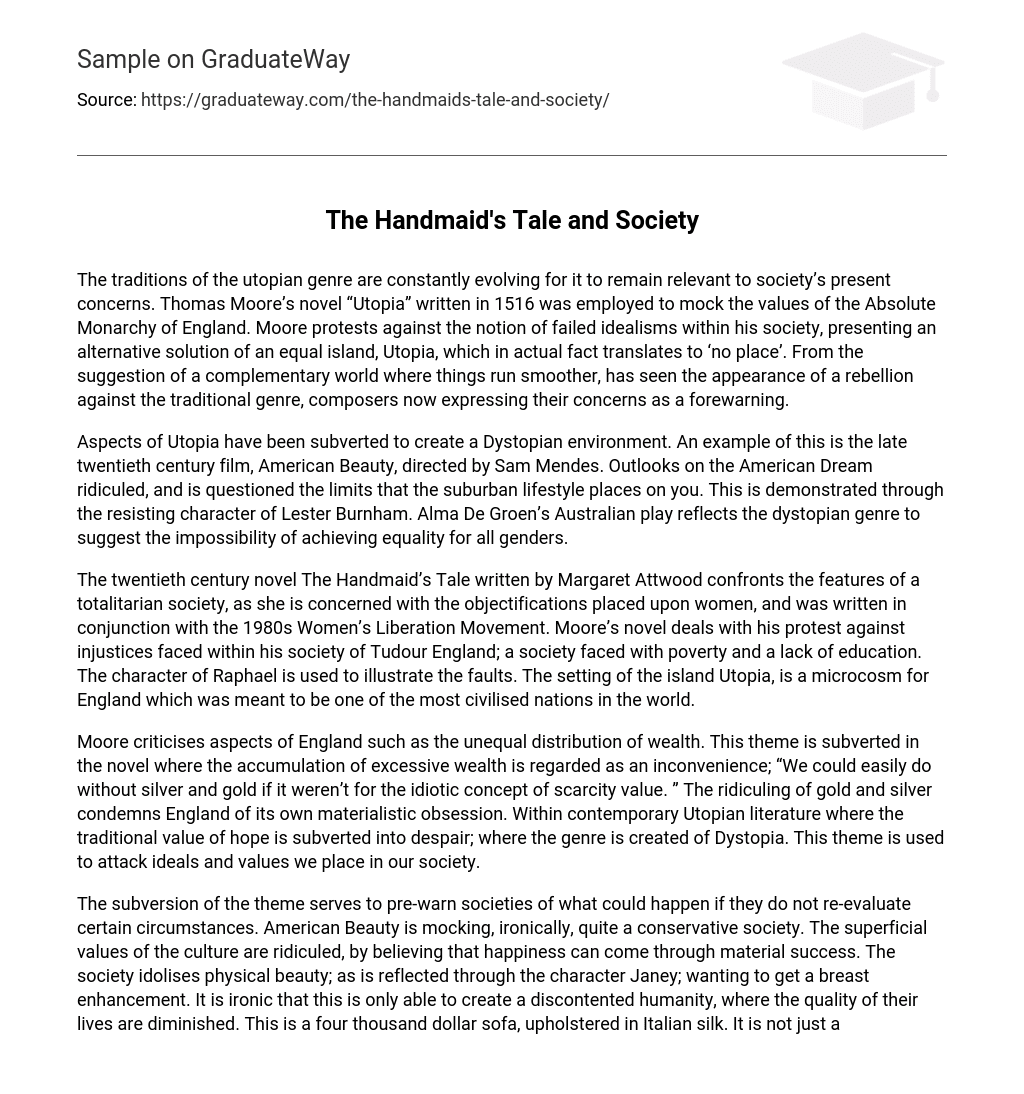The traditions of the utopian genre are constantly evolving for it to remain relevant to society’s present concerns. Thomas Moore’s novel “Utopia” written in 1516 was employed to mock the values of the Absolute Monarchy of England. Moore protests against the notion of failed idealisms within his society, presenting an alternative solution of an equal island, Utopia, which in actual fact translates to ‘no place’. From the suggestion of a complementary world where things run smoother, has seen the appearance of a rebellion against the traditional genre, composers now expressing their concerns as a forewarning.
Aspects of Utopia have been subverted to create a Dystopian environment. An example of this is the late twentieth century film, American Beauty, directed by Sam Mendes. Outlooks on the American Dream ridiculed, and is questioned the limits that the suburban lifestyle places on you. This is demonstrated through the resisting character of Lester Burnham. Alma De Groen’s Australian play reflects the dystopian genre to suggest the impossibility of achieving equality for all genders.
The twentieth century novel The Handmaid’s Tale written by Margaret Attwood confronts the features of a totalitarian society, as she is concerned with the objectifications placed upon women, and was written in conjunction with the 1980s Women’s Liberation Movement. Moore’s novel deals with his protest against injustices faced within his society of Tudour England; a society faced with poverty and a lack of education. The character of Raphael is used to illustrate the faults. The setting of the island Utopia, is a microcosm for England which was meant to be one of the most civilised nations in the world.
Moore criticises aspects of England such as the unequal distribution of wealth. This theme is subverted in the novel where the accumulation of excessive wealth is regarded as an inconvenience; “We could easily do without silver and gold if it weren’t for the idiotic concept of scarcity value. ” The ridiculing of gold and silver condemns England of its own materialistic obsession. Within contemporary Utopian literature where the traditional value of hope is subverted into despair; where the genre is created of Dystopia. This theme is used to attack ideals and values we place in our society.
The subversion of the theme serves to pre-warn societies of what could happen if they do not re-evaluate certain circumstances. American Beauty is mocking, ironically, quite a conservative society. The superficial values of the culture are ridiculed, by believing that happiness can come through material success. The society idolises physical beauty; as is reflected through the character Janey; wanting to get a breast enhancement. It is ironic that this is only able to create a discontented humanity, where the quality of their lives are diminished. This is a four thousand dollar sofa, upholstered in Italian silk. It is not just a couch” Karolin represents this concept, where she cares more for the possession of the couch than the relationship with her husband; Lester. Moore presents the idea of an egalitarian society through the alternative society of Utopia. The island which he created is theoretical. This is represented through the island; being shaped like a crescent moon. It symbolised lunatic; insanity, that this place was madness that had been taken to the extreme.
The dystopian text, Rivers of China, challenges the notion of whether gender equality is achievable; “If we just had access to scientific knowledge I reckon we could figure it out. But they like to keep us stupid. ” Wayne explains this to the man, who is actually Katherine Mansfield, and the parallels between the imaginary matriarchy and patriarchy are evident. The use of split setting shows the similarities between two kinds of totalitarian societies; the 1920s phallocentric society and 1980s feminist society. The two are juxtaposed as part of her protest for failed idealism.
The archetype of Katherine Mansfield is utilized to represent women in the society who face inequality and repression due to their gender. There is the underlying message that gender shouldn’t matter as she is taken from one society as a woman, into the other as a man. In both setting, she suffers from tuberculosis which is a metaphor for the destructive nature of repression on a particular part in society. The novel Utopia explores the idea of personal freedom through the equal conformity that each citizen obeys to.
Epitomizing this is the clothing that they wear; each is described to be very similar, equally comfortable in hot and cold weather and varying only slightly to sex and marital status. The genre in the Handmaid’s Tale becomes more confronting when juxtaposed to Thomas Moore’s Utopia. The novel was written to liberate the objectification put on women during the time. The society of Gilead is constructed where women are defined solely by their gender roles as Wives, Handmaid’s or Marthas, they have been stripped of individual names, but instead are recognised by the name of their commander.
Gilead is able to remain in control over the women’s bodies by maintaining control over their bodies and what they wear. The protagonist; Offred, is placed in a situation that restricts her extensively compared to the freedom her former life gave her. He hoped to provoke reflection, through abolishing money he hoped that some people would react and be a bit more generous. People to measure and evaluate their own society.





